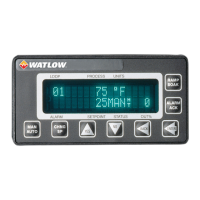CLS200 Series User’s Guide
Chapter 7: Turning and Control
136
Setting Up and Tuning PID Loops
After installing your control system, tune each control loop and then set the loop to automatic
control. When tuning a loop, choose PID parameters that will best control the process. This section
gives PID values for a variety of heating and cooling applications.
NOTE! Tuning is a slow process. After adjusting a loop, allow about 20 minutes for the
change to take effect.
Proportional Band (PB) Settings
Table 7.1 shows proportional band settings for various temperatures in degrees Fahrenheit or
Celsius.
Table 7.1 — Proportional Band Settings
TEMPERATURE
SETPOINT
PB
TEMPERATURE
SETPOINT
PB
TEMPERATURE
SETPOINT
PB
-100 to 99 20 1100 to 1199 75 2200 to 2299 135
100 to 199 20 1200 to 1299 80 2300 to 2399 140
200 to 299 30 1300 to 1399 85 2400 to 2499 145
300 to 399 35 1400 to 1499 90 2500 to 2599 150
400 to 499 40 1500 to 1599 95 2600 to 2699 155
500 to 599 45 1600 to 1699 100 2700 to 2799 160
600 to 699 50 1700 to 1799 105 2800 to 2899 165
700 to 799 55 1800 to 1899 110 2900 to 2999 170
800 to 899 60 1900 to 1999 120 3000 to 3099 175
900 to 999 65 2000 to 2099 125 3100 to 3199 180
1000 to 1099 70 2100 to 2199 130 3200 to 3299 185
As a general rule, set the proportional band to 10% of the setpoint below 1000° and 5% of the
setpoint above 1000°. This setting is useful as a starting value.
Integral Settings
The controller’s integral parameter (TI) is set in seconds per repeat. Some other products use an
integral term called reset, in units of repeats per minute. Table 7.2 shows integral settings versus
reset settings.

